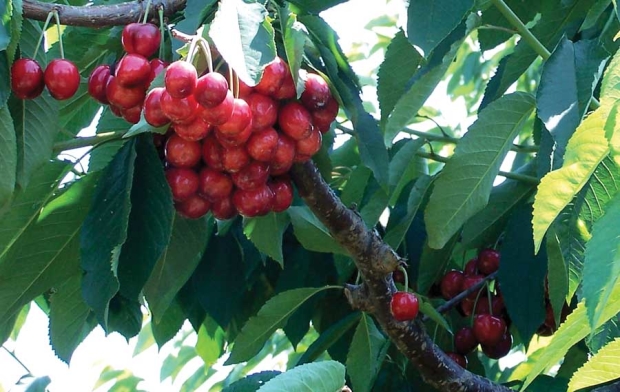
Research over the past two years shows irrigation can be reduced prior to harvest without harming sweet cherry fruit yield or quality for some varieties, including Lapins. (Good Fruit Grower file)
Many growers believe that a cherry orchard must receive a full supply of water up to harvest to avoid stressing the trees and to maximize fruit size.
Others think that cutting off irrigation early — sometimes by as much as three weeks before harvest — will increase fruit firmness and improve resistance to cracking induced by rain.
So, who’s right?
It’s a question Washington State University graduate student Nadia Valverdi aimed to answer with a research study in Washington and Oregon over the past two years.
The importance goes beyond just settling a debate. Drought conditions across the West in recent years have reduced water supplies and heightened the need for conservation. At the same time, how deficit irrigation might really affect orchards and fruit remained unknown.
Valverdi examined the role near-harvest irrigation plays on key fruit quality traits, as well as susceptibility to splitting, in early-maturing, midseason and late-ripening varieties.
Valverdi focused on four cherry varieties for the project — Chelan, Lapins, Skeena and Sweetheart — measuring soil texture, soil moisture, stem water potential, shoot growth, fruit growth, cracking index, fruit quality and yield in three commercial orchards in Washington and Oregon.
Overall, she found that irrigation can be reduced prior to harvest without harming sweet cherry fruit yield or quality for some varieties.
“We have to improve water use efficiency at farm level due to resource conservation needs, and this research suggests we can conserve water without affecting fruit quality or tree health,” Valverdi said at the 2016 Northwest Cherry Research Review in Wenatchee, Washington.
Chelan

Nadia Valverdi
The first trial involved a drip-irrigated block of 12-year-old Chelan cherry trees on Mazzard rootstock in Pasco, Washington. The trees are planted in sandy soil referred to as “the beach,” Valverdi said.
In 2014, Valverdi terminated irrigation 17 days before harvest in one row and 10 days later on another row.
The following year, she terminated irrigation 24 days before harvest and 10 days later.
Fruit from those trees were compared to fruit from trees irrigated under the standard irrigation rate for that orchard, which was every five or six days for 12 hours. The deficit irrigation showed no effect on fruit quality or yield, she found. The variety also showed high resistance to cracking both years.
As to the trees, she observed no stem water potential stress, and while soil moisture declined at all depths, trees continued to access water from deeper in the soil profile.
Lapins
The second trial involved a micro-sprinkler irrigated block of 14-year-old Lapins cherry trees on Mazzard rootstock in Brewster, Washington, planted in more acidic, heavy soil.
Valverdi terminated irrigation at 21 days before harvest and 10 days later in 2014, and at 18 days before harvest and 10 days later in 2015.
Fruit from those trees were compared to fruit from trees irrigated every five or six days for 12 hours, which was the commercial standard for that orchard.
For the Lapins cherries, fruit soluble solid content increased by 10 percent to 13 percent in both years under the deficit irrigation treatments, though there was a reduction in fruit firmness both years.
Lapins on deficit irrigation before harvest appeared to be slightly more susceptible than Chelans to cracking in 2014, but they showed increased resistance in 2015.
Soil moisture declined at all depths without reaching the permanent wilting point.
The decline in soil water content in the top 2 feet suggested that water resources were exhausted in those zones, and the trees were under moderate stress, but the trees also pulled water from deeper underground, the study showed.
Skeena and Sweetheart
The final trials involved drip-irrigated blocks of Skeena and Sweetheart cherries on Gisela 6 rootstock in Dufur, Oregon.
Valverdi terminated irrigation at five, 10 and 15 days before harvest on different rows in a block in 2014 for both varieties and in 2015 for Sweethearts.
For Skeenas, irrigation was terminated at only nine and three days before harvest in 2015 due to the early harvest. The typical irrigation set was 12 hours every third day.
For Skeena cherries, fruit size was smaller under deficit irrigation before harvest, though yield was not affected, and trees experienced moderate to severe stress. For Sweethearts, fruit size, weight and quality were reduced, even as yield was not affected.
Conclusions
The study involved mature trees with big root systems, Valverdi noted. In the case of Skeena and Sweetheart, the cultivars are on Gisela 6, a dwarfing rootstock, which may explain the effects on the fruit.
“Their root system is not as big, which may be why they are more sensitive,” she said.
Overall, though, the study concluded that withholding irrigation prior to harvest does not consistently improve quality or reduce susceptibility to splitting in sweet cherries. More specifically, withholding irrigation up to 24 days before harvest did not affect splitting susceptibility on Chelan and Lapins.
The study also showed that stem water potential is a good indicator of tree water stress.
The message for growers: If there is less water available, don’t be afraid to be more conservative with it before harvest.
“Don’t be afraid to water less than you normally do at that point, because the fruit will not be affected,” Valverdi said. “The only thing the tree is doing is ripening fruit, and it has all the water it needs at that point to do that already.”
The Washington Tree Fruit Research Commission funded the project. Collaborators were Dr. Matt Whiting, WSU horticulturist; Dr. Todd Einhorn, research horticulturist with Oregon State University in Hood River, Oregon; and Dr. Ines Hanrahan, projects manager for the Research Commission. •
– by Shannon Dininny






Leave A Comment